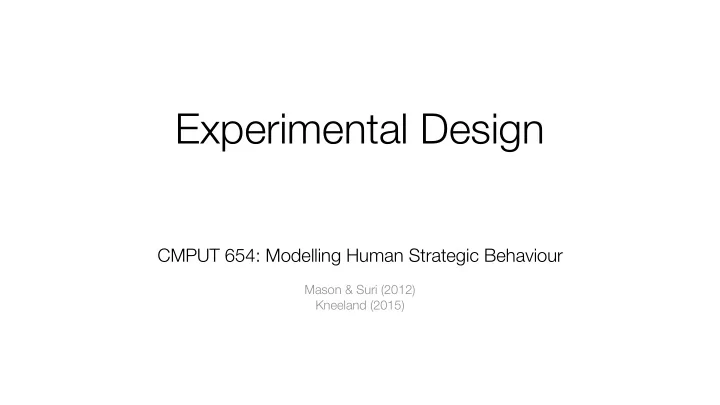

Experimental Design CMPUT 654: Modelling Human Strategic Behaviour Mason & Suri (2012) Kneeland (2015)
Lecture Outline 1. Presentation scheduling 2. Behavioural research on Mechanical Turk 3. Identifying higher-order rationality
Presentation Scheduling 10 slots available, and 10 people registered in the class* Question: Are there any group projects? Procedure: 1. Serial dictatorship: I have constructed a randomized order of students. Each student may claim any slot that has not been claimed by an earlier student. 2. Ascending auction: Any student may 'steal' a slot by giving up 1% of their presentation mark; if anyone tries this, we'll have an auction denominated in marks for the slot.
Mason & Suri (2012) Why: Collects a lot of issues with doing behavioural research together • Kind of a handbook for conducting crowdsourced research , kind of a handbook for conducting research specifically using Mechanical Turk • Advantages of MTurk • Validity of MTurk data • Unique issues
Mechanical Turk • Requester posts Human Intelligence Tasks • Workers select a task from a big list, work on it • For a few minutes, typically; tasks are pretty small • Workers paid base rate, optionally a bonus • Amazon takes a cut • The tasks can be used for behavioural experiments
Advantages of MTurk • Large subject pool • Reliable availability • Subject pool diversity • Although still not representative of any particular population • Inexpensive (in both time and money)
Logistics • Random assignment based on worker IDs • Many assignments versus one assignment per HIT • How much to pay workers?
Unique Issues • Spammers 1. Captcha/verifiable questions 2. Peer review 3. Low-entropy response detection • Attrition 1. Timeouts, automatic default responses 2. Just discard entire trial
Synchronous Experiments • Waiting room • Build a panel of subjects using a pilot project • Notify the night before about specific time • Contact 3 n subjects to get n participants
Ethics ★ GET APPROVAL FROM RESEARCH ETHICS BOARD BEFORE PERFORMING ANY BEHAVIOURAL EXPERIMENTS • It's not as painful as you might fear • They want you to know exactly what your experiment will look like, but you can usually file amendments • Equity issues; is it really fair to pay subjects so little?
Kneeland (2015) Why: • Example of a clever methodology for a big problem in choice-based studies • Use of epistemic types in empirical work • How many steps of higher-order belief in rationality are there? • Without making unreasonably strong assumptions
Inference from Choice Data Two ways to check rationality assumptions: 1. Elicit beliefs and choices, and see if choices are best response to beliefs • Problem: Doesn't really work for higher-order beliefs 2. Measure rationality directly from choice data • Requires a structural model ( why? ) • What if the model is too strong?
Choices in Bimatrix Games • Two players of a bimatrix game are each others' opponents • That means that it's hard to distinguish low-order beliefs from high-order beliefs ( why? ) • Solution: ring games • Each player is the opponent of the next player • So each level of reasoning is thinking about a different player
Identification Strategy • Player 4 has a dominant strategy, Player 3 has a best response to player 4's dominant strategy, etc. • Pairs of games that change only a single players' payoffs (to swap the dominant strategy) • Higher-order reasoners will spot the swap, lower-order reasoners will not • This is the natural exclusion restriction • Question: How is this weaker than a structural assumption? • Players play all 4 roles in each of 2 games
Epistemic Types • Each player has a set T i of epistemic types • Each type has a belief about the type of its opponents • A type is rational if it maximizes expected utility relative to its beliefs • A type is m th -order rational if it satisfies m th -order rationality • Question: Is this the same or different from the types we studied in Bayesian games?
Results F IGURE 7.—Subjects classified by order of rationality, by treatment.
Recommend
More recommend